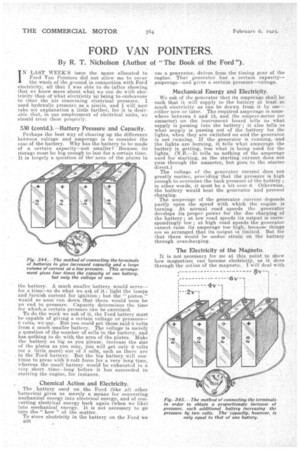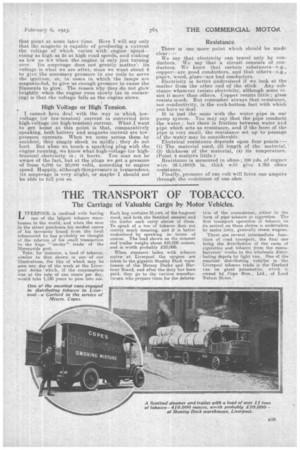FORD VAN POINTERS.
Page 22

Page 23

If you've noticed an error in this article please click here to report it so we can fix it.
By R. T. Nicholson (Author of "The Book of the Ford ").
IN LAST WEEK'S issue the space allocated to Ford Van Pointers did not allow me to cover the whole of the ground in connection with Ford electricity, all that I was able to do (after showing that we know more about what we can do with electricity than of what electricity is) being to:endeavour to clear the air concerning electrical pressure. • I used hydraulic pressure as a simile, and I will now take my explanation • a little farther, for it is desirable that, in our employment of electrical units, we should treat them properly.
530 (contd.).---Battery Pressure and Capacity.
Perhaps the best Way of clearing up the difference betWeen voltage and amperage is to consider the case of the battery. Why has the battery to be made of a certain capacity--not smaller? Because its storage must be big enough to last for a certain time. it is largely a question of the' area, of the plates in the battery. A much smaller battery would serve— for a time—to do what we ask of it : light the lamps and furnish current for ignition ; but the " piston " would so soon run down that there would soon he
an end to pressure. Capacity determines the time•for which.a certain pressure can be exerdised.
To do the work we ask of it, the Ford battery must be capable of giving a certain voltage or pressure6 volts, we say. But you could get those said i volts from a much smaller battery. The voltage is merely a question of the number of cells in the battery, and has nothing to do with the area of the plates. Make the battery as big as you please, increase the size of the plates as you may, you will get only 6 volts (or a little more) out of 3 cells, such as there are in the Ford battery. But the big battery will continue to press with 6-volt force for a Very long time, whereas the small battery would be exhausted in a very short.time-long before it has succeeded in starting the engine, for instance.
Chemical Action and Electricity.
The .battery used on the Ford (like All other batteries) gives us merely a means for converting mechanical energy into electrical energy, and of converting electrical energy back again (when we like) into mechanical energy. It is not necessary to go into the " how" of the matter.
To store electricity in the battery on the Ford we 538 use a generator, driven from the timing gear of the engine. That generator has a certain capacityarn.perage—and gives a certain pressure—voltage.
Mechanical Energy and Electricity.
We ask of the generator that its amperage shall be such. that it will supply to the battery at least so much electricity as can be drawn from it by use— either now or later. The required amperage is somewhere between 8 and 12, and the ampere-meter (or ammeter) on the instrument board tells us what supply is passing into the battery ; it also tells us what supply is passing out of the battery for the lights, when they are switched on and the generator is not running. If the generator is running, and the lights are burning, it tells what amperage the battery is getting, less what it being used for the lights. (NB.—It tells us nothing of the amperage used for starting, as the starting current does not pass through the ammeter, but goes. to the starter, direct.)
The voltage of the generator current does not greatly matter, providing that the pressure is high. enough to overcome the back pressure of the battery ; in other words, it must be a bit over 6. Otherwise, the battery would beat the generator and prevent charging. The amperage of the generator current depends partly upon the speed with which the engine is turning. At normal road speeds the generator develops its proper power for the due charging of the battery ; at low road speeds its output is correspondingly low ; at high road speeds the generator cannot raise its amperage' too high, because things are so arranged that its output. is limited. But for that there would be undue strain on the battery through overcharging. .
The Electricity of the Magneto.
It is not necessary for me at this point to show how magnetism can become electricity, as it does through the action of the magneto. I will deal with • that point at some later time. Here I will say only that the magneto is capable of producifig a current the voltage of which varies With engine Speed— rising as high, as 24 at high road speeds, and sinking as low as 6-8 when the engine is only just turning over. Its amperage does not greatly matter': its voltage is what we are after, since we want about 6 to give the necessary pressure in our coils to serve the ignition, or, in cases in which the lamps are magneto-fed, to give us enough pressure to cause the Elements to glow. The reason why they do not glow brightly when the engine runs slowly (as in corner • log) is that the voltage falls as the engine slows..
High Voltage or High Tension.
I cannot here deal with the way in which lowvoltage (or low-tension) current is converted into high-voltage (or high-tension) current. What I want to get home at this point is that, comparatively speaking, both battery and magneto current are lowPressure currents. When we come across them -by accident, they sim,ply shock us mildly; they do not hurt. But when we touch a sparking plug with the engine running, we know what higavvoltage (or hightension) electricity is ; it hurts. You may not be aware of the fact, but at the plugs we get a pressure of from 8,000 to 20,000 volts, according to engine • speed. Happily, although this pressure is tremendous,
• its amperage is very slight, or maybe I should not be able to tell you so. Resistance.
There is one more point which should be made clear :— We say that electricity can travel only by conductors. We say that a circuit consists of conductors. We know that certain substances—e.g., copper—are good conductors, and that others—e,g., paper, wood, glass—are bad conductors. Electricity is better understood if we look at the matter from the other end of the stick, Any substance whatever resists electricity, although some resist it more than others. Copper resists little ; glass resists much. But remember always that resistance, not conductivity, is the rock-bottom fact with which you have to deal. it is just the same with the water pipe in our pump system. You may say that the pipe conducts the water ; but there is friction between water and pipe which acts as resistance, and if the bore of the pipe is very small, the resistance set up to passage of the water n/ay be considerable.
Electrical resistance depends upon four points :(1) The material used, (2) length of the material, (3) thickness of the material, (4) its temperature. (Point 4 matters little.) Resistance is measured in ohms ;100 yds. of copper wire 36-1,000tii in. thick will 'give 2.3'62 ohms resistance.
Finally, pressure of one volt will force one ampere through theresistance of one ohm




























